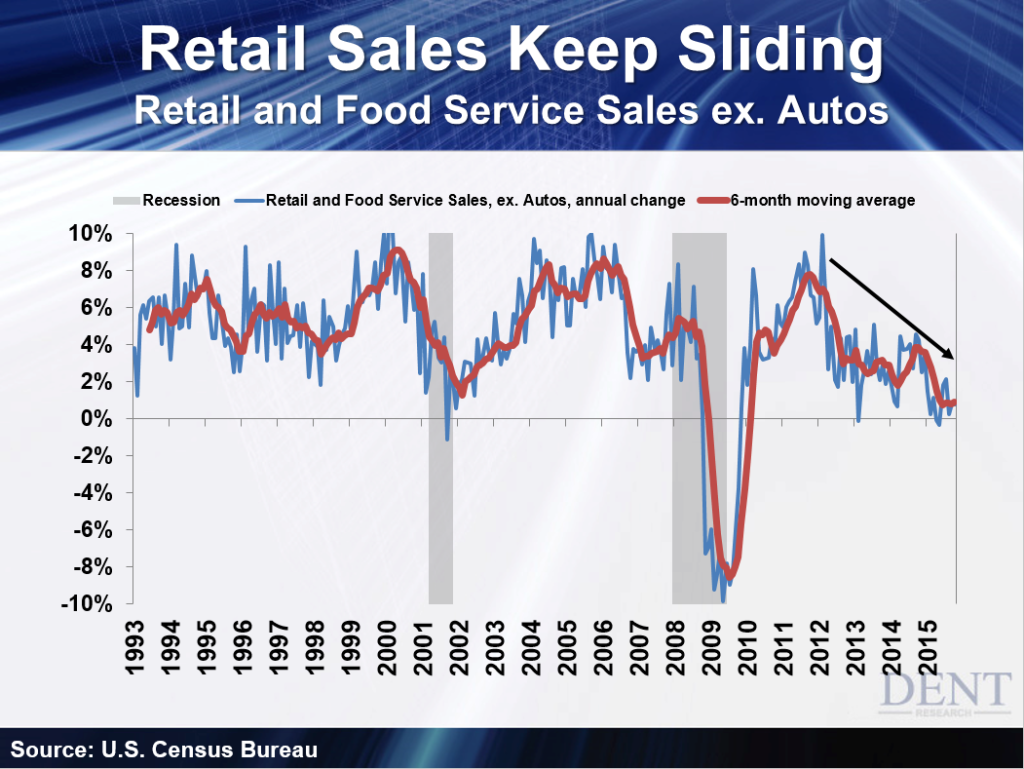Before the Paris attacks, which I discussed Monday, the markets were already reeling from weaker-than-expected retail sales.
Profits were a big miss for upscale retailer Nordstrom (N:JWN) and department store giant Macy’s (N:M). Nordstrom’s stock fell 22% at its worst on that news. And Macy’s – that sucker’s down almost 50% from its July peak.
But Nordstrom is not Macy’s, as anyone who shops there will undoubtedly let you know. It’s ritzy, swanky, and serves a higher clientele – the affluent who’ve up to this point been holding up the economy. They’re the ones who peak in spending later – much later than the average person. They’re the ones who have benefited most from quantitative easing, which has caused an even bigger bubble in the financial assets, which they largely own.
Now, their time has come. I’ve been forecasting this affluent sector would decline starting by 2016, and Nordstrom’s seems to be proving that.
But the real story comes from looking at growth rates in retail sales over the long term…
Retail sales excluding automobiles have been slowing since 2012. In 2015, they’ve been approaching zero-percent growth. Bad news.
They’re now lower than in the worst of the 2001 recession… and much lower than when the Great Recession began in January 2008.
More bad news!
This sort of indicator is important because it tells you how the economy is doing right now.
Economists revel over lagging indicators like jobs growth that tell the story after the fact (because they’re idiots). Ideally we’d focus on leading indicators, but most of those don’t work in an artificial QE- and ZIRP-driven economy.
But retail sales correlate directly with consumer spending and therefore the economy. That makes them the ultimate consumer-focused coincident indicator that you should focus on near a top.
And as you can see – they stink!

The trends are very consistent with what we’ve been forecasting – a slowing economy in the second half of the year – and reveal why, amidst rising geopolitical challenges, the Fed may still keep interest rates at zero in December, despite the “strong” October jobs report compelling them to do otherwise.
To understand this, there’s two numbers you need to remember: 46, and 54.
46 is the age when people on average reach peak spending, after which it plateaus for a few years. We conducted a 10-year analysis many years ago that reached this conclusion.
54 is the year that plateau ends. It’s also the year when the affluent – a smaller, more impactful subset of the overall group – reach their peak, and they’re doing so today.
So it’s no coincidence that we saw a recession after late 2007 when the average baby boomer turned 46.
Now, eight years later, they’re turning 54, when they come off that plateau and the affluent peak in spending. This is also when auto sales – one of the few remaining bright spots in our economy – finally declines sharply.
But it’s the affluent sector that I’m most concerned about because they control so much of the spending – 50%!
This was not the case in generation cycles before. But that changed heading into the bubbly late 1990s when they racketed up so much of the wealth, and wealth and income inequality became as severe as in the late 1920s bubble boom.
In 1989, spending by age in five-year cohorts (the best we had back then) saw the biggest dropoff come between age 50 to 54. Now, it comes between age 55 to 59.
And that’s the age they reach as we step into 2016, when the real demographic cliff hits.

Nobody will see this next recession coming, as they won’t see similar fallouts in Germany and much of Europe going into 2016 as well.
But you will. This year the stage has been set for a much worse collapse than we saw in 2008.
